Air ambulance
An air ambulance is an aircraft used for emergency medical assistance in situations where either a traditional ambulance cannot easily or quickly reach the scene or the patient needs to be repositioned at a distance where air transportation is most practical.

Air ambulance crews are
supplied with equipment that enables them to provide medical treatment to a critically injured or ill patient. Common equipment for air ambulances includes ventilators, medication, an ECG and monitoring unit, CPR equipment, and stretchers.
Air ambulance : history
Military
As with many innovations in Emergency Medical Service (EMS) the concept of transporting the injured by aircraft has it's origins in the military. The concept of using aircraft as ambulances is almost as old as powered flight itself. During the First World War air ambulances were tested by various military organizations. Aircraft were still primitive, with limited capabilities, and received mixed reviews. The exploration of the idea continued however, and by 1936, an organized military air ambulance service was evacuating wounded from the Spanish Civil War for medical treatment in Nazi Germany. The first dedicated use of helicopters by U.S. forces occurred during the Korean War during the period from 1950-1953. While popularly depicted as simply removing casualties from the battlefield (which they did) the use of helicopters also stretched to moving critical patients to more advanced hospital ships, once initial emergency treatment in field hospitals had occurred. The knowledge and expertise at the use of aircraft as ambulances continued to evolve, and by 1969, in Vietnam, the use of specially trained medical corpsmen and helicopters as ambulances led U.S. researchers to conclude that servicemen wounded in battle had better rates of survival than motorists injured on California freeways, and inspired the first experiments with the use of civilian paramedics in the world. The use of military aircraft as battlefield ambulances continues to grow and develop today in a variety of countries, as does the use of fixed wing aircraft for long distance travel, including repatriation of the wounded.
 Older version of a Danish air ambulance |  Light helicopters like this Bell 47 Sioux removed the wounded from the battlefield (Korea)  | H-19 moves wounded to more advanced care offshore (Korea) |
Air ambulance : Civilian
The first civilian uses of aircraft as ambulances were probably incidental. In northern Canada, Australia, and in the Scandinavian countries, remote, sparsely populated settlements were often inaccessible by road for months at a time, or even year round. In some cases in Scandinavia, as in Norway, the primary means of transportation between communities was by boat. As an early part of aviation history, many of these communities were served by civilian "bush" pilots, flying small aircraft, and transporting supplies, mail, and visiting doctors or nurses to isolated communities. These pilots probably performed the first civilian air ambulance trips, albeit on an ad hoc basis, but clearly, a need for such services existed. In 1928 the first formal, full-time air ambulance service was established in the Australian outback. This organization became the Royal Flying Doctor Service and continues operating to the present. In 1934, the first civil air ambulance service in Africa was established in Morocco by Marie Marvingt.
 King Air 200 Ambulance |  King Air | |
Air ambulances were useful in remote areas, but did they serve a practical purpose in the developed world? Following the end of the Second World War, the first civilian air ambulance in North America was established by the Saskatchewan government in
Pilatus PC 12/45
Regina, Saskatchewan, Canada, which had its own issues of both remote communities and great distances to consider in the provision of health care to its citizens. This service was still in operation in 2007. Back in the United States, 1947 saw the creation of the Schaefer Air Service, the first air ambulance service in the United States. This service was founded by J. Walter Schaefer of Schaefer Ambulance Service in Los Angeles, California. Schaefer Air Service was also the first FAA-certified air ambulance service in the United States. It should be noted that, at the time of the creation of these services, paramedicine was still decades away, and, unless the patient was accompanied by a physician or nurse, they operated primarily as medical transportation services. A great deal of the early use of aircraft as ambulances in civilian life, particularly helicopters, involved the improvised use of aircraft belonging to branches of the military. Eventually this would become more organized. This mode of usage occurred not only in the United States, but also in other countries, and persists to this day.
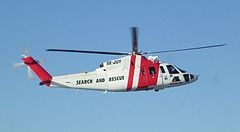 Swedish Search and Rescue |  Dutch Search and Rescue |
Two programs were implemented in the U.S. to assess the impact of medical helicopters on mortality and morbidity in the civilian arena. Project CARESOM was established in Mississippi in 1969. Three helicopters were purchased through a federal grant and located strategically in north, central and southern areas of the state. Upon termination of the grant the program was considered a success and each of the three communities was given the opportunity to continue the helicopter operation. Only the one located in Hattiesburg did so, thereby establishing the first civilian air medical program in the United States. The second program, the Military Assistance to Safety and Traffic (MAST) system, was established in Fort Sam Houston in San Antonio in 1969. This was an experiment by the Department of Transportation to study the feasibility of using military helicopters to augment existing civilian emergency medical services. These programs were highly successful at establishing the need for such services. The remaining challenge was in how such services could be operated most cost-effectively. In many cases, as agencies, branches and departments of the civilian governments began to operate aircraft for other purposes, these too were frequently pressed into service to provide cost-effective air support to the evolving Emergency Medical Services.
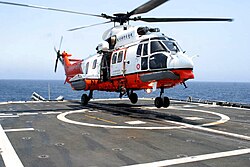 Hong Kong Goverment Flying Service | 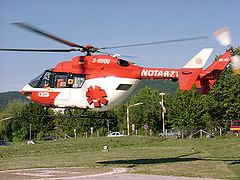 German Air Rescue - DRF |
As the concept was proven, dedicated civilian air ambulances began to appear. On November 1, 1970, the first permanent civil air ambulance helicopter Christoph 1 entered service at the Hospital of Harlaching, Munich, Germany. The apparent success led to a

| Italian Government Helicopter |
quick expansion of the concept across Germany, with Christoph 10 entering service in 1975, Christoph 20 in 1981 and Christoph 51 in 1989. As of 2007 there are about 80 helicopters named after Saint Christopher, like Christoph Europa 5 (also serving Denmark), Christoph Brandenburg or Christoph Murnau. Austria adopted the German system in 1983 when Christophorus 1 entered service at Innsbruck. The first civilian, hospital-based medical helicopter program in the United States began operation in 1972.[8] Flight For Life Colorado began with a single Alouette III helicopter, based at St. Anthony Central Hospital in Denver, Colorado. In Ontario, Canada, the air ambulance program began in 1977, and featured a paramedic-based system of care, with the presence of physicians or nurses being relatively unusual. The system, operated by the Ontario Ministry of Health, began with a single rotor-wing aircraft based in Toronto. An important difference in the Ontario program involves the emphasis of service. 'On scene' calls were done, although less commonly, and a great deal of the initial emphasis of the program was on the interfacility transfer of critical care patients. Operating today through a private contractor (ORNGE) the system operates 33 aircraft stationed at 26 bases across the province, performing both interfacility transfers and on-scene responses in support of ground-based EMS. Ornge operates the largest and most sophisticated program of aero-medical transport in North America. Over 17,000 admissions are dispatched annually making Ornge North America's largest operator in the field of transport medicine. Today, across the world, the presence of civilian air ambulances has become commonplace, and is seen as a much-needed support for ground-based EMS systems.
 Ontario's ORNGE Program |  West Palm Beach, Florida 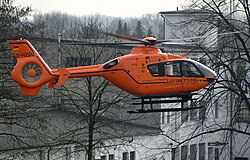 | German 'Christoph' Air Ambulance of the Federal Ministry of the Interior |

Air ambulance : Organization
Air ambulance service, sometimes called Aeromedical Evacuation or simply Medevac is provided by a variety of different sources, in different places in the world. There are a number of reasonable methods of differentiating types of air ambulance services. These include military/civilian models, government-funded, fee-for-service, donated by a business enterprise, or funded by public donations. It may also be reasonable to differentiate between dedicated aircraft and those with multiple purposes and roles. Finally, it is reasonable to differentiate by the type of aircraft used, including rotary-wing, fixed-wing, or very large aircraft. The military role in civil air ambulance operations is described in the History section. Each of the remaining models will be explored separately. It should also be noted that this information applies to air ambulance systems performing emergency service. In almost all jurisdictions, private aircraft charter companies provide non-emergency air ambulance service on a fee-for-service basis.
Government operated

In some cases, air ambulance services will be provided by a level of government, either directly, or by means of a negotiated contract with a commercial service provider, such as an aircraft charter company. Such services may focus on the transfer of critical care patients, may support ground-based EMS on scenes, or may perform a combination of these roles. In almost all cases, the government will provide guidelines for use to both hospitals and EMS systems, in order to keep operating costs under control, and may specify operating procedures in some level of detail in order to limit potential liability, but almost always takes a 'hands-off' approach to the actual running of the system, relying instead on local managers with subject matter (physicians and aviation executives) expertise. Ontario's ORNGE program and the Polish LPR are examples of this type of operating system.
Air ambulance : Multiple purpose

In some jurisdictions, cost is a major consideration, and the presence of dedicated air ambulances is simply not practical. In these cases, the aircraft may be operated by another government or quasi-government agency, and made available to EMS for air ambulance service when required. In southern Queensland, Australia, the helicopter is actually operated by the local hydroelectric utility, with the Queensland Ambulance Service or New South Wales Ambulance Service providing paramedics, as required. In some cases, the flight paramedic will be provided to the aircraft operator by local EMS on an as-needed basis. In other cases, the paramedic will staff the aircraft full-time, but will have a dual function. In the case of the Maryland State Police, for example, the paramedic is a serving State Trooper whose job is to act as the Observer Officer on a police helicopter when not required for medical emergencies.
Fee-for-service

In many cases, local jurisdictions may not charge for air ambulance service, particularly for emergency calls. This is not, however, universally true. The cost of providing air ambulance services is considerable, and many such services, including governments, charge for service. There are certain groups which, in particular, charge for service. These tend to be privately-owned companies, such as aircraft charter companies, hospitals, and some private-for-profit EMS systems. Within the European Union, almost all air ambulance service is on a fee-for-service basis, except for those systems which operate by private subscription. Many jurisdictions have a mix of operation types. Fee-for-service operators are generally responsible for their own organization, but may have to meet government licensing requirements. Rega of Switzerland is an example of such a service.

In some cases, a local business or even a multi-national company may choose to fund local air ambulance service as a goodwill or public relations gesture. Examples of this are common in the European Union, where in London the Virgin Corporation funds the Helicopter Emergency Medical Service, and in Germany a large number of the 'Christoph' air ambulance operations are actually funded by ADAC, Germany's largest automobile club. In Australia and New Zealand, many air ambulance helicopter operations are sponsored by the Westpac Bank. In these cases, the operation may vary, but is the result of a carefully negotiated agreement between government, EMS, hospitals, and the donor. In most cases, while the sponsor will receive advertising exposure in exchange for funding, they take a 'hands off' approach to daily operations, relying instead on subject matter specialists.

Air ambulance : Public donations
In some cases, air ambulance services may be provided by means of voluntary charitable fundraising, as opposed to government funding, or may receive limited government subsidy to supplement local donations. Some countries use a mix of such systems, such as the U.K.. In Scotland, the parliament has voted to fund air ambulance service directly, through the Scottish Ambulance Service. In England and Wales, however, the service is funded on a charitable basis via a number of local charities for each region covered.
Air ambulance : Operating model
The operating model for the EMS system is often a valid way of differentiating air ambulances. The Anglo-American model tends to be paramedic-led, with occasional in-field involvement by physicians and nurses. In these cases, the emphasis is on the transport of the patient to definitive care; usually in a hospital. While supportive and life-saving care may occur, the aircraft exists primarily as a means of transportation for the patient. Many hospital-based systems in the U.S. are examples of this model. In the Franco-German model, the response is physician-led, with a doctor attending on almost every call. The emphasis here is to bring definitive care rapidly to the patient, wherever they are. This may involve considerable 'on-scene' times, as physicians attempt complex interventions which would, in the other model not be attempted until the patient reached the hospital. In these cases, the helicopter is a means of delivery of the physician and supporting staff (paramedic or nurse) to the scene. Transport is generally accomplished using a ground ambulance, and air transport occurs only in the most dire of circumstances. The French SAMU system is an example of this model. The lines of distinction can be somewhat blurred with these models, as systems which use the Anglo-American model for ground ambulances may instead use the Franco-German approach to air ambulance service. The Dutch system is an example of this, as is the HEMS program in London, England.
 Franco-German model |  Dutch Crossover model | Anglo-American model |
Air ambulance : "Heavy-lift"


A final area of distinction which requires mention is the operation of truly large aircraft, generally fixed-wing in nature, as air ambulances. The infrequency of demand for such a service in the civilian sphere means that the majority of such operations are confined to the military, which requires them in support of overseas combat operations. Military organizations with a capability of this type of specialized operation include the United States Air Force, the German Luftwaffe, and the British Royal Air Force. Each operates aircraft staffed by physicians, nurses, and corpsmen/technicians, and each has the capability of providing long distance transport, along with all required medical support, to dozens of injured persons simultaneously. One exception to the 'military-only' rule is the German automobile club, ADAC, which operates a large air ambulance aircraft specifically for the repatriation of individuals who subscribe to their own or affiliated travel insurance and protection plans.
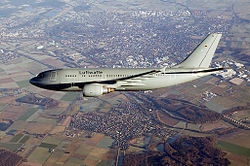 German Luftwaffe A310  |  German Auto Club Dornier 328 | USAF C-17 Globemaster |
Standards
Aircraft and flight crews
In most jurisdictions air ambulance pilots are required to have a great deal of experience in piloting their aircraft because the conditions of air ambulance flights are often more challenging than regular non-emergency flight services. After a spike in air ambulance crashes in the United States in the 1990s, the US government and the Commission on Air Medical Transportation Systems (CAMTS) have stepped up the accreditation and air ambulance flight requirements, ensuring that all pilots, personnel, and aircraft meet much higher standards than what was previously required. The resulting CAMTS accreditation, which applies only in the United States, includes the requirement for an air ambulance company to own and operate its own aircraft. Some air ambulance companies, realizing it is virtually impossible to have the correct medicalized aircraft for every mission, instead charter aircraft based on the mission-specific requirements.
While in principle CAMTS accreditation is voluntary, a number of government jurisdictions require companies providing medical transportation services to have CAMTS accreditation in order to be licensed to operate. This is an increasing trend as state health services agencies address the issues surrounding the safety of emergency medical services flights. Some examples are the states of Colorado, New Jersey, New Mexico Utah, and Washington.According to the rationale used to justify Washington's adopting the accreditation requirments, requiring accreditation of air ambulance services provides assurance that the service meets national public safety standards. The accreditation is done by professionals who are qualified to determine air ambulance safety. In addition, compliance with accreditation standards is done on a continual basis by the accrediting organization. Their accreditation standards are periodically revised to reflect the dynamic, changing environment of medical transport with considerable input from all disciplines of the medical profession.
Other states require either CAMTS accreditation or a demonstrated equivalent, such as Rhode Island and Texas, which has adopted CAMTS' Accreditation Standards (Sixth Edition, October 2004) as its own. In Texas, an operator not wishing to become CAMTS accredited must submit to an equivalent survey by state auditors who are CAMTS-trained. Virginia and Oklahoma have also adopted CAMTS accreditation standards as their state licensing standards. While the original intent of CAMTS was to provide an American standard, air ambulance services in a number of other countries, including three in Canada and one in South Africa, have voluntarily submitted themselves to CAMTS accreditation.

Air ambulance : medical staffing
The medical crew of an air ambulance varies depending on country, area, service provider and by type of air ambulance. In those schemes operating under the Anglo-American model of service delivery, the helicopter is most likely to be used to transport patients, and the crew may consist of Emergency Medical Technicians, Paramedics, flight nurses, or in some cases, a physician. Those services with a primary focus on critical care transport are more likely to be staffed by physicians and nurses. In the Franco-German model, the aircraft is much more likely to be used as a method of delivering high-level support to ground-based EMS. In these cases, the crew generally consists of a physician, often a surgeon, anesthetist, trauma specialist or similar specialty, accompanied by a specially-trained advance care paramedic or nurse. In these cases, the object is the rapid delivery of definitive care, occasionally even performing emergency surgical procedures in the field, with the eventual transport of the patient being accomplished by ground ambulance, not the helicopter.
Air ambulance : Medical control
The nature of the air operation will frequently determine the type of medical control required. In most cases, the available skill set is considerably greater than that of a typical paramedic. As a result, those operating in this environment will often be permitted to exercise more latitude in medical decision-making. Assessment skills tend to be considerably higher, and particularly on interfacility transfers, permit the inclusion of such factors as the reading of x-rays and the interpretation of lab results. This permits advance planning, consultation with supervising physicians, and the issuing contingency orders, in case they are required during the flight. Some systems operate almost entirely off-line, using protocols for almost all procedures and only resorting to on-line medical control when protocols have been exhausted. Some air ambulance operations have full-time, on-site medical directors with pertinent backgrounds (e.g., emergency medicine); others have medical directors who are only available on pager. For those systems operating on the Franco-German model, the physician is almost always physically present, and medical control is not an issue.
Air ambulance : Equipment and interiors
Most aircraft used as air ambulances, with the exception of charter aircraft and some military aircraft, are equipped for advanced life support, and have interiors that reflect this. The challenge in most air ambulance operations, and particularly with helicopters, are the high ambient noise levels and limited amounts of working space, both of which create significant issues for the provision of ongoing care. While equipment levels tend to be high, and very conveniently grouped, it may not be possible perform some assessment procedures, such as chest auscultation, while in flight. In some types of aircraft, the aircraft's design means that the entire patient will not be physically accessible in flight. Additional issues occur with respect to pressurization of the aircraft. Not all aircraft used as air ambulances in all jurisdictions have pressurized cabins, and those which do typically tend to be pressurized to only 10,000 feet above sea level. These pressure changes require advanced knowledge by flight staff with respect to the specifics of aviation medicine, including changes in physiology and the behaviour of gases.
 Typical helicopter interior  |  Typical helicopter interior | Fixed-wing interior |
Air ambulance : Challenges
During the 1990s there occurred a trend of increasing numbers of air ambulance crashes, mostly involving helicopters. By 2005, this number had reached a record high. Crash rates from 2000–2005 more than doubled the previous five year's rates. To some extent, these numbers had been accepted, as it was understood that the very nature of air ambulance operations meant that, because a life was at stake, air ambulances would often operate on the very edge of their safety envelopes, going on missions in conditions where no other civilian pilot would fly. As one side result, it should be noted that of all EMS personnel losing their lives in the line of duty in the United States, nearly fifty percent do so on air ambulance crashes. In 2006, the United States National Transportation Safety Board (NTSB) deems that many air ambulances crashes were avoidable, eventually leading to the improvement of government standards and CAMTS accreditation.
Other notable air ambulance services
- St John Ambulance Australia
- STARS (Canada)
- SMURD (Romania)
- Mayoral Executive Jet (Spain)
- Air Methods - Largest US air ambulance operator.
- ARCH Air Medical Service (US)
- Flight for Life (US)
- Life Flight (US)
- Stat Medevac (US)
- Hi Flying (India)








Aucun commentaire:
Enregistrer un commentaire